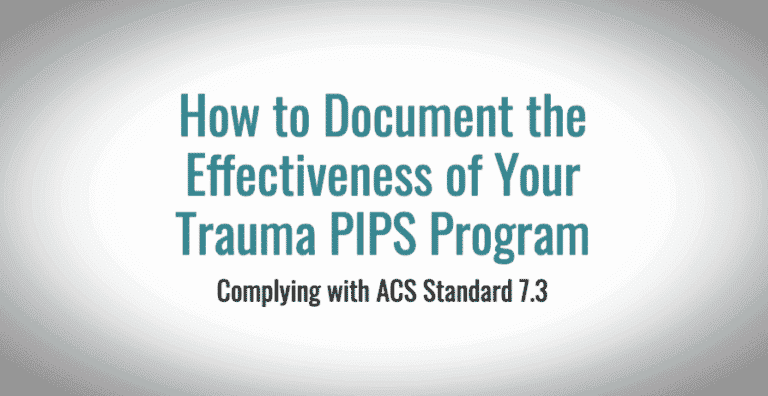The new 2022 trauma center verification standards from the American College of Surgeons (ACS) require centers to have documented evidence that their performance improvement and patient safety (PIPS) program is effective (Standard 7.3). Is this requirement new? Yes and no.
The implicit goal of Resources for Optimal Care of the Injured Patient has always been effectiveness in terms of better patient care. In fact, the previous version of the standards (the “Orange Book”) explicitly referenced “effective performance improvement.”
However, the 2022 standards introduce a subtle change in emphasis. The Orange Book paid a lot of attention to activities like event identification, benchmarking and corrective action. But focusing on activities can lead to a “checking the box” mentality. The purpose of the new Standard 7.3 is to make sure no one loses sight of the main goal — to improve a trauma program’s performance and the safety of its patients.
A respondent to the recent Trauma System News survey on the new standards wrote, “I am currently struggling with PIPS loop closure and with identifying exactly what is expected — data points or metrics — to demonstrate effectiveness.”
What data do you need to demonstrate the effectiveness of your PIPS program? To answer this question, it is important to realize that data is the key to not only documenting PIPS effectiveness but driving it as well. The first step is to establish a foundation of good trauma data.
Make sure you are capturing all audit filters and complications
Standard 7.3 specifies that trauma centers must have documented evidence of “effective use of audit filters”. This is the perfect starting point because audit filters are the foundation of PIPS. In my experience, however, there are two common problems:
- Many centers do not actually capture audit filter data. Their PIPS plan includes a list of filters, but registrars do not capture these data points when abstracting patient charts. As a result, program leaders cannot run reports to understand how frequently their audit events are occurring.
- Just as important, many trauma programs do not capture a full range of patient complications in the registry. This is a problem because a robust view of complications is critical to understanding patient care.
If your center is not capturing this data (or if you capture some data but have room for improvement), follow these steps:
First, make sure your center’s PIPS plan includes the audit and event filters listed in the “Resources” section of Standard 7.2. This list represents the new required minimum for audit filter utilization.

Second, make sure your PIPS plan specifies the complications that will be captured in your registry. What complications should you track? The new standards do not provide much guidance. The only mention of complications is in Standard 7.2, where the list of required audit filters includes “significant complications and adverse events”.
I suggest starting with the original list of complications developed by the National Trauma Registry of the American College of Surgeons (NTRACS). While the NTRACS complication list is no longer published, it remains a valuable reference. (You can access an example of the list here in Word or PDF format.) You should also track the “Hospital Events” listed in the NTDS Data Dictionary. In addition, make sure to track any specific complications that your facility is following — for example, any “failure to follow guideline” events.
Third, make sure all filters and complications are making it into the registry. Most trauma registry software systems include the NTRACS complications, so it is easy to enable these fields.
Fourth, make sure any provider-related audit filters and complications are assigned to a provider. This will facilitate your center’s documentation of an effective Ongoing Professional Practice Evaluation (OPPE) process.
Shift your focus from cases to problems
Based on what I have seen at trauma centers across the U.S., the biggest obstacle to an efficient and effective PIPS program is an excessive focus on cases.
How does this play out? Typically, the PI coordinator or trauma program manager puts a lot of effort into creating very detailed case summaries for adverse events. These summaries include the full play-by-play details of a patient’s care, but little insight into what caused the problem in the first place.

How do you shift your focus from cases to problems? First, as noted above, make sure a full range of audit filters and complications are being captured in the trauma registry. Then, continue to review cases as required, but spend less time on creating exhaustive case summaries.
The best case summaries are very specific to the event that occurred — what it was, what led up to it and what was done about it. There is no need to include daily vital signs, daily lab values and other details unless they are relevant to the adverse event. Just make sure all relevant audit filters and complications are flagged.
Here is an example of a case summary that is well focused on the event and leaves out unnecessary detail:
Reason for review:
- No EMS form
- Unable to intubate – EMS
- Death
Case summary:
48y M s/p moped v auto. Un-helmeted driver struck by auto at intersection. Unk time of injury.
2058 EMS called to scene and found patient unresponsive with agonal respirations. Unable to obtain BP on scene. BVM ventilations initiated. Attempted intubation “multiple times” without success. Noted multiple extremity fxs, rigid abd, facial inj, open skull fx. Ext fxs immobilized by EMS. Transported by RW.
RW notification 2123.
RW on scene 2152: HR 158, RR 16 (some spontaneous breathing noted), GCS 5. Unable to obtain O2 sat. Unable to obtain manual BP – attempted via L thigh. Patient is cold to touch.
2155 Initiated PRBC via IO. Second IO placed UE.
2202 HR 150, asst RR 16, GCS 5. Given etomidate and rocuronium for intubation. Video laryngoscopy x1 attempt successful by RW crew.
2207 Second unit PRBC given. HR 110, EtCO2 39, GCS 3.
2210 transferred to aircraft. HR 87, O2 sat 88%, EtCO2 35. Palpable carotid pulse noted.
2217 HR 56, O2 sat 83%, EtCO2 19. Noted PVC’s and bradycardia. CPR initiated. Concern with developing tension ptx. Decision to divert to closest trauma center.
2220 Needle thoracostomy performed bilat. No response noted – PEA – CPR continued. Epi x2 given with no response.
2234 Arrived in ED as Full TTA. ATLS continued. Noted subcutaneous air throughout his body. FAST showed bilat ptx – bilat chest tubes placed with improved ability to ventilate. Given Epi with no response.
2244 code stopped, pt died.
Again, the key is to put less time into unneeded detail and more time into identifying relevant audit filters and complications. This lets trauma program leaders use trauma registry reports to evaluate individual cases in the light of aggregate performance. To illustrate the point, consider these two scenarios:
Scenario 1: A patient experiences a delay to the OR. However, a registry report driven by the relevant audit filter shows that this is not a trend in performance and therefore not a system problem in your trauma center. Action: Identify and document the causes of this event and continue to use audit filters to monitor overall performance.
Scenario 2: A patient experiences a delay to the OR. You run a registry report and find that your center has experienced a dozen similar delays in the last quarter. This is a system problem at your trauma center. Action: Engage OR leadership to review the data, discuss the issues and develop a corrective action plan.
The goal of a corrective action plan is to resolve an event’s underlying problem or contributing factors. I recommend using a problem-focused PI methodology to both document system issues and guide action. For example, a one-page PDSA (Plan-Do-Study-Act) form can effectively document:
- What is the problem?
- What is our target?
- What is our corrective action?
- How will we know (in terms of “measures of compliance”) when we have fixed the problem?
To streamline corrective actions planning, focus on creating well-designed “guardrails” and “stop sign” plans. (See Corrective action plans: 2 basic types that cover most trauma PI issues.)
To effectively document loop closure, remember that the key is using data to show performance over time. (See How to use compliance auditing to demonstrate trauma loop closure.)
Benchmark data is another important tool for staying focused on problems and not being distracted by the details of individual cases. Centers that participate in the Trauma Quality Improvement Program (TQIP) can use their semiannual reports to identify problems. (For specific ideas on how to work with these reports, see How to use your TQIP report to prepare for a verification survey.)
Even if your center participates in TQIP, you should also develop a PI dashboard that tracks all TQIP measures. Whenever an issue “flashes red” on your benchmark report or your dashboard, it indicates the existence of a problem that needs to be addressed via a corrective action and documented with a PDSA or similar methodology.
Leverage PIPS meeting agendas and minutes
The measures of compliance in Standard 7.3 include “peer review minutes.” Ideally, your center’s meeting minutes will provide ACS reviewers with a clear account of your PIPS efforts. In most trauma programs, however, minutes and other meeting documentation lack enough detail to be useful for reviewers.
To make the most of these documents:
- Make sure PIPS meeting agendas specify exactly which patients and events will be discussed during the upcoming session.
- Capture action plans within meeting minutes. (Note that any opportunity for improvement should have an action plan. However, if an OFI corresponds with a current action plan for a previously identified problem, simply reference the existing PDSA.)
- Following the meeting, immediately carry over identified action plans to populate the next meeting’s agenda as an open item.
This process applies to all PIPS-related meetings: trauma multidisciplinary PIPS committee, peer review, secondary review meetings with TMD, prehospital PI, etc.
It ensures that agendas and minutes tell a coherent story — how your PIPS program is identifying problems, what actions are being taken and how the loop is being closed.
Comprehensive approach to the PIPS effectiveness standard
The approach described above will help trauma program leaders comply with the most challenging parts of Standard 7.3:
- Document effective use of audit filters by making sure filters and complications are captured in the registry and used to identify system- and provider-level problems.
- Document attempts at corrective actions by using a PDSA or similar tool to plan and guide problem-focused action plans.
- Document loop closure and strategies for sustained improvement measured over time by fully leveraging meeting agendas and minutes to tell a coherent PIPS story.
In addition, this approach addresses key components of Standard 7.3’s measures of compliance, including peer review minutes, loop closure documentation, monitoring of event rates, OPPE and benchmarking reports.
Bonus: The approach described above will also help your center comply with Standard 7.2. This standard requires PIPS plans to outline a process for using audit filters, event reviews and benchmarking reports to identify annual “priority areas for PI”.
Angie Chisolm, MBA, BSN, RN, CFRN, TCRN is managing partner at Peregrine Health Services. She is a nationally recognized expert in trauma program operational efficiency, coding and billing, site survey readiness and performance improvement. Angie is also chief operating officer and co-founder of National Quality Systems (NQS), a data management platform for trauma centers.

